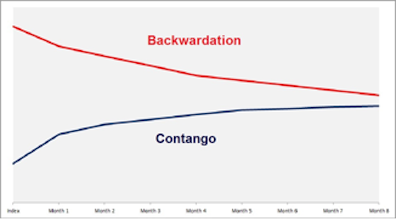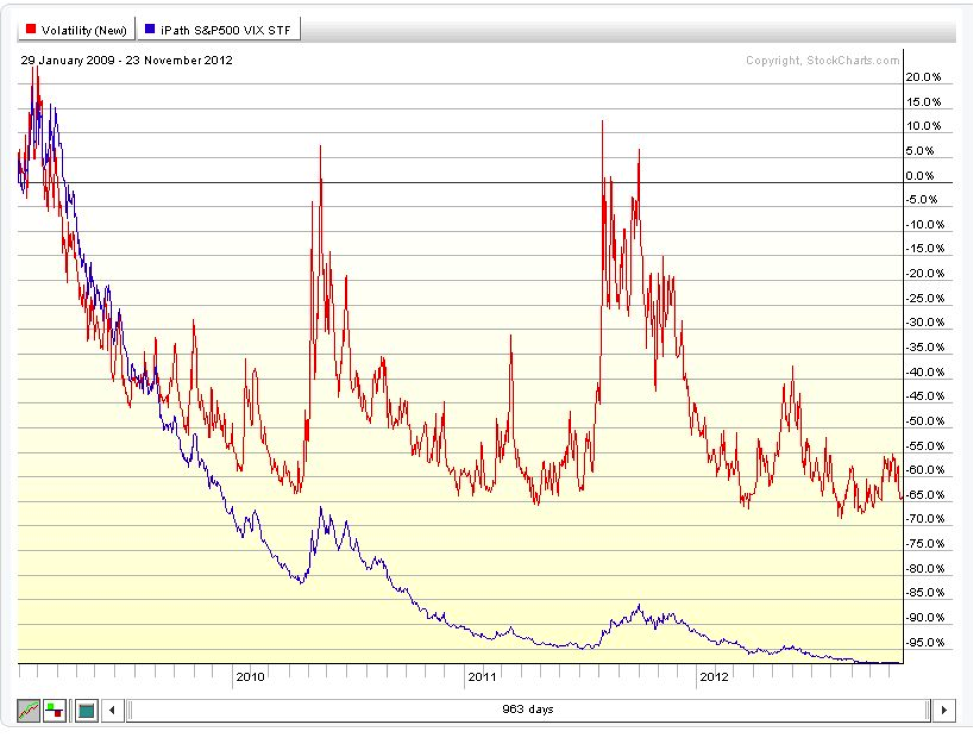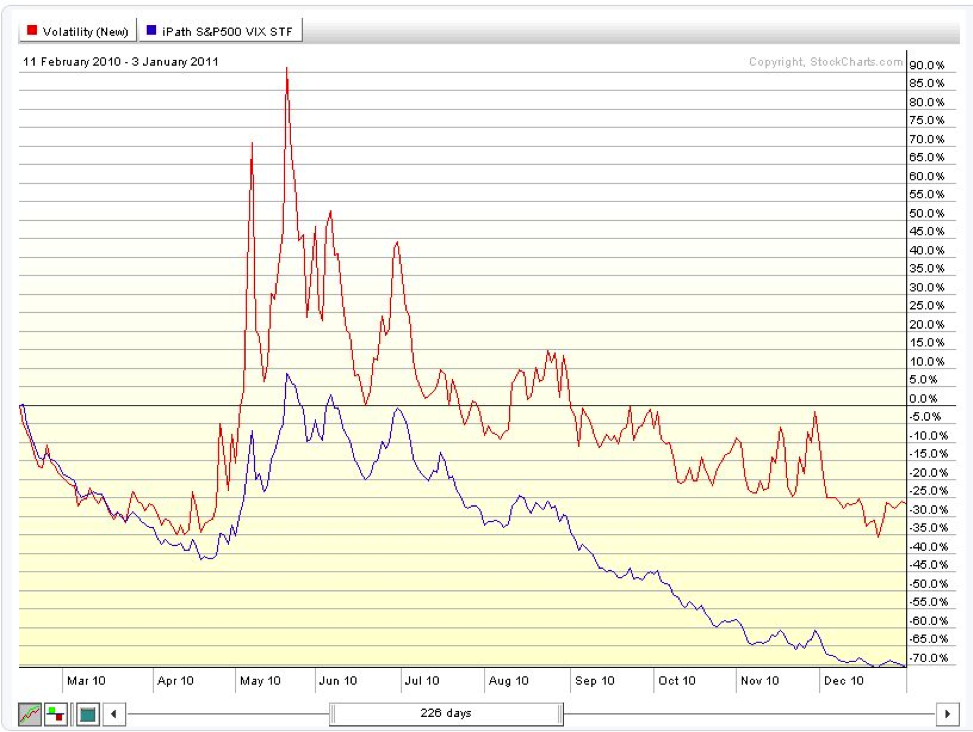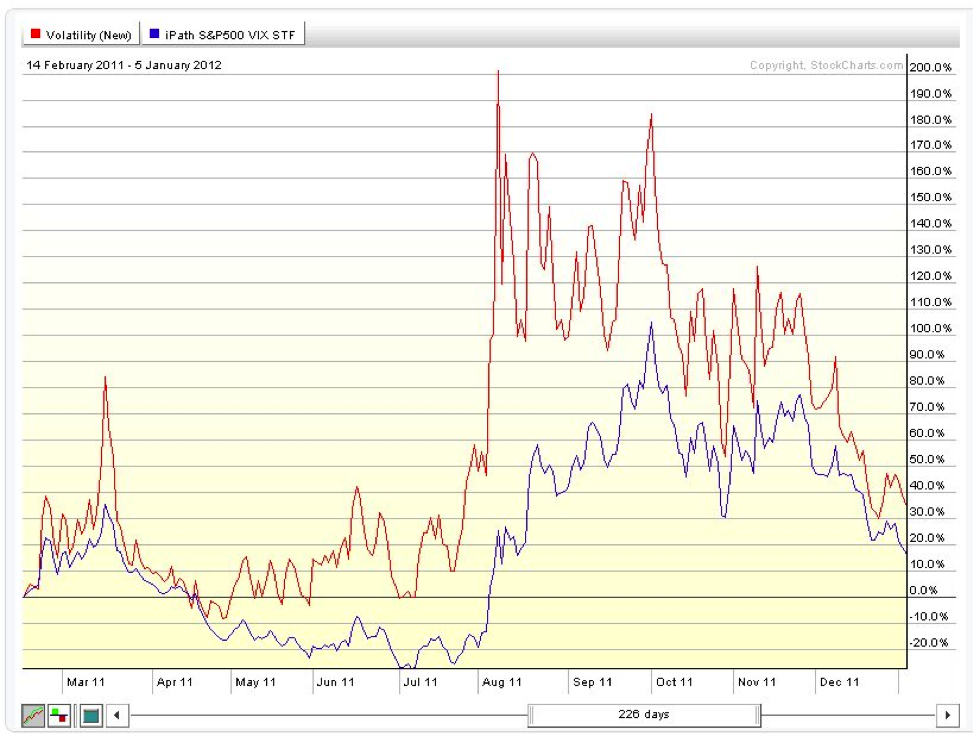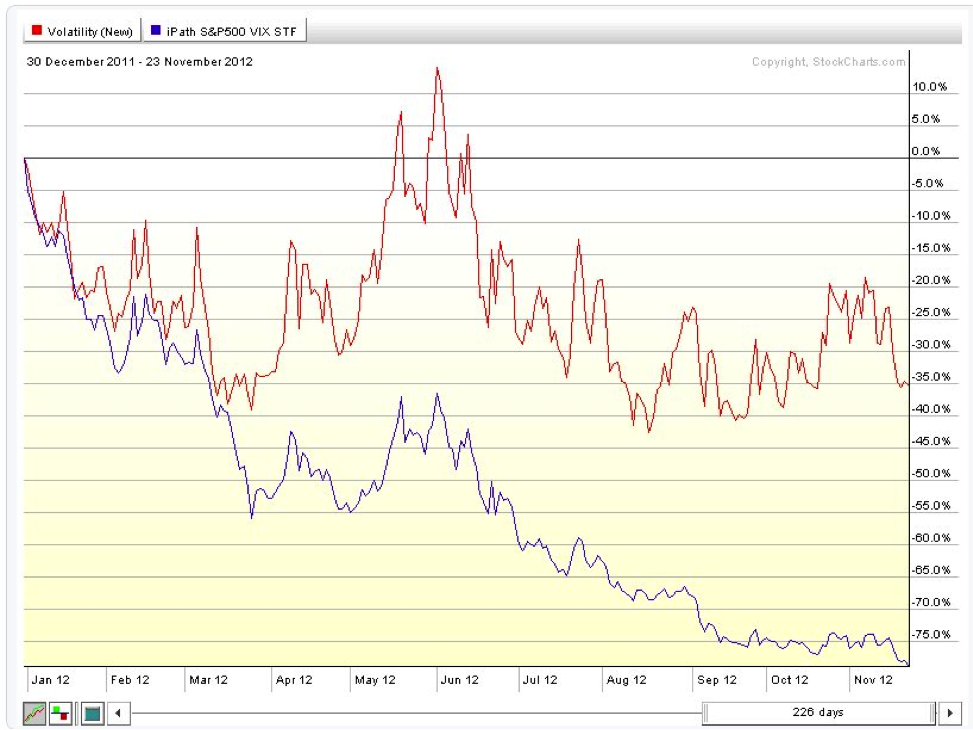I have been analyzing this market anomaly for some time now and am glad to be able to showcase my findings here on See It Market.
For those of you who are not familiar with the iPath S&P 500 VIX Short-Term Futures ETN (VXX), I want to briefly outline what it is and why I think it is something to pay attention to if you are an active trader.
Below is a description of the VXX ETF found on the iPath Website:
The S&P 500 VIX Short-Term Futures™ Index TR is designed to provide access to equity market volatility through CBOE Volatility Index® (the “VIX Index”) futures. Specifically, the S&P 500 VIX Short-Term Futures™ Index TR offers exposure to a daily rolling long position in the first and second month VIX futures contracts and reflects the implied volatility of the S&P 500® Index at various points along the volatility forward curve. The index futures roll continuously throughout each month from the first month VIX futures contract into the second month VIX futures contract.
It is my opinion that this dynamic allocation and active rebalance of the VXX creates a trading vehicle that can be of great assistance when you are looking for a trade to take advantage of declining volatility and/or even a rising/flat stock market. This is because the VXX has a DECAY effect that is very consistent and significant over time and is more pronounced as long as the CBOE VIX futures curve remains in “contango.”
Here’s the Problem
Every month the VXX suffers from negative roll yield when the CBOE VIX futures curve is in contango. The VXX Fund must “roll” its futures to rebalance to the later contract and as the expiration date nears, it is forced to sell its closest to expiry contracts and buy the next dated contracts. The purchases are often at higher prices if the curve is in contango, thus losing the spread amount between the two contracts that are rebalancing.
You can always see what the shape of the VIX futures curve is directly from the CBOE website.
You can also see the VXX current allocation at any time on the iPath website.
This Decay, like the slow leak of a tire, which I call “the death drip” has been, and continues to be, very significant over long periods of time, especially in prolonged periods of VIX Term structure contango. Below are some Charts illustrating this effect:
Since Inception 2009-01-29 the VXX is down 98.02% while the VIX is only down 65% over the same time period.
In order to get an even closer look at this effect I have also provided comparison charts for each year respectively since 2009.
Note: VXX vs VIX 2009 under performance of -15.66%
Note: VIX vs VIX 2010 under performance of -42.93%
Note: VXX vs VIX under performance 2011 of -22.59%
Note: VXX vs VIX 2012 under performance of -43.07 %
Barclays has attempted to stem the perpetual decline by reverse splitting the fund, but this, in my view, simply extends its shelf life. This will let the decay continue all over again until the VXX drifts back into the single digits where Barclays will reverse split again and…wash, rinse, repeat, around the merry go round we go. The inability for the VXX to provide a long-term hedge against fat tail risk should be very clear by now. The next question regarding this anomaly is how can a trader possibly benefit from this?
Easy Conclusion
– Avoid it like the plague. If it walks like a duck, quacks like a duck, and looks like a duck, it probably isn’t a chicken. – JD
– If it doesn’t look like it hedges volatility it probably doesn’t.
Wind at your Back Method– Declining Volatility
One simple tactic that I have used is when I expect a decline in volatility and/or a rise in the general stock market, I look to short the VXX ETF knowing that the prescribed “decay” affect will actually aid the positions possible performance over time. I have also tested bearish call spreads using option leverage for the same affect. After examining the use of puts, I have concluded that this “Decay Premium” is often priced in and generally does not seem like the most efficient way to make a bearish speculation.
Free Money Arbitrage
Lastly, I want to leave you all with an outline of a trading strategy that I have been testing for about one year now and am currently trying to optimize. My initial reaction to this EUREKEA! moment I had about this time last year was to just short the correlation/covariance adjusted spread between the two (short VXX shares and long CBOE VIX futures contracts in perpetuity).
This simple spread trade was relatively successful but has made me gradually gravitate towards options writing strategies that could possibly provide less risk and potentially higher rewards. Other tested strategies have included short diagonal call calendar spreads in the VXX and Short naked calls in VXX that are Hedged with Long CBOE VIX calls, the latter being an extremely risky strategy due to the naked short call position in the VXX. This combination, albeit risky, was very profitable during the Sept 2012 to Nov 2012 period because the VXX calls expired worthless and the VIX calls I purchased ended up in the money. However, I believe this to be a rare occurrence.
Beware! I have gone back and looked at every period of comparison for the VXX and the CBOE VIX and there are certain periods of time that the VXX will actually outperform the VIX. Note that this out performance normally does not extend past 60-90 days. Additionally, since there is not that much historical data for statistically significant comparison and I would also take note that this analysis is bordering on uncharted territory and cannot be assumed to hold in the future till more time passes and data is added to the comparison.
Optimization
Additionally, I am also attempting to apply a ratio adjustment component to how many VXX shares / call options I weight short vs. VIX futures / call options I weight long based on the slope of the VIX futures curve and the sustained duration of a specific slope. This analysis has proven quite complex and difficult to confirm so its still under construction. Russell Rhoads @RussellRhoads of the CBOE Options Institute, is the Grand Master of the CBOE VIX and has provided me statistics that put the CBOE VIX in contango approximately 75% amount of the time since 2007. So I would expect the decay to be effective 75% of the time or more. The goal of optimization would be to know when an advantageous time to apply higher amounts of leverage to the spread given the probability of the curve staying or steepening in contango.
Disclaimer: This in no way constitutes investing advice. All of these opinions are my own and I am simply sharing them. I am not trying to convince anybody to do anything with their money. I am simply offering up ideas for the sake of discussion. As always, everybody is expected to do their own due diligence and to ultimately be comfortable with their own investing decisions. Any actions taken based on the views expressed in this blog are solely the responsibility of the user. In no event will Aether Analytics or its owner be liable for any decision made or action taken by you based upon the information and/or opinion provided in this blog.
———————————————————
Twitter: @InterestRateArb and @seeitmarket Facebook: See It Market
At the time of publication, the author was Short VXX Call Options, Long CBOE VIX Options
Any opinions expressed herein are solely those of the author, and do not in any way represent the views or opinions of his employer or any other person or entity.

